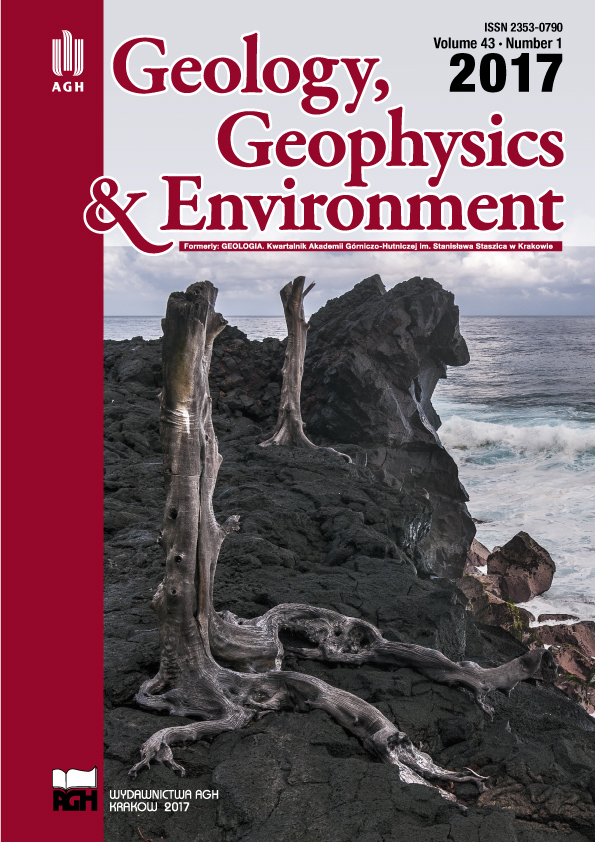The impact of the mineral composition of Carboniferous claystones on the water-induced changes of their geomechanical properties
DOI:
https://doi.org/10.7494/geol.2017.43.1.43Keywords:
Carboniferous claystones, geomechanical properties, water-induced changes, mineral compositionAbstract
In this article, the authors describe the characteristics and changes of geomechanical properties of Carbonifeorus claystones as related to their mineral composition and the time of soaking in water. Geomechanical properties, including bulk density, Young modulus, Poisson ratio, unconfined compressive strength, durability index, and swelling index were examined in dry rock samples, and in water-soaked samples after 3 hours of soaking, and 6 hours of soaking respectively. Changes in the geomechanical properties of rocks were also examined as a function of their mineralogical composition. In particular, the properties of rocks were examined in relation to present aluminosilicates and layered aluminosilicates, respectively. Changes in the geomechanical properties were also examined relative to the presence of minerals anatase and siderite. Correlation coefficients between physical parameters and mineral composition were examined. It was determined that the total quantity of aluminosilcates is a better predictor of geomechanical properties after soaking, than only the content of layered aluminosilicates. Calculated correlation coefficients were generally higher for most samples after 6 hours of soaking than after 3 hours of soaking. It was also determined that the increase of bulk density correlates much better with the mineral anatase content, than with the siderite content.Downloads
References
Abd El Megeed K.M., 2013. Improvement of swelling clay properties using hay fibers. Construction and Building Materials, 38, 242–247.
Bolewski A. & Manecki A., 1984. Mineralogia opisowa. Skrypty Uczelniane – Akademia Górniczo-Hutnicza im. Stanisława Staszica, 932, AGH, Kraków.
Bukowska M., 2012. Skłonność górotworu do tąpań – geologiczne i geomechaniczne metody badań. Główny Instytut Górnictwa, Katowice.
Bukowski P. & Bukowska M., 2012. Changes of some of the mechanical properties of rocks and rock mass in conditions of mining exploitation and mine workings flooding. AGH Journal of Mining and Geoengineering, 36, 1, 57– 6 7.
Hoek E. & Brown E.T., 1997. Practical estimates of rock mass strength. International Journal of Rock Mechanics and Mining Sciences, 34, 8, 1165–1186.
Josh M., Esteban L., Delle Piane C., Sarout J., Dewhurst D.N. & Clennell M.B., 2012. Laboratory characterisation of shale properties. Journal of Petroleum Science and Engineering, 88–89, 107–124.
Kabiesz J., 1988. Zmiana własności wytrzymałościowych skał karbońskich pod wpływem ich nawilgocenia. Bezpieczeństwo Pracy, 4, 23–25.
Kidybiński A., 2004. Geotechniczne aspekty adaptacji wyrobisk likwidowanych kopalń węgla na podziemne magazyny gazu. Prace Naukowe GIG. Górnictwo i Środowisko, 2, 37–63.
Labani M.M. & Rezaee R., 2015. The Importance of Geochemical Parameters and Shale Composition on Rock Mechanical Properties of Gas Shale Reservoirs: a Case Study from the Kockatea Shale and Carynginia Formation from the Perth Basin, Western Australia. Rock Mechanics and Rock Engineering, 48, 3, 1249–125.
Li D., Wong L.N.Y., Liu G. & Zhang X., 2012. Influence of water content and anisotropy on the strength and deformability of low porosity meta-sedimentary rocks under triaxial compression. Engineering Geology, 126, 46–66.
Lyu Q., Ranjith P.G., Long X., Kang Y. & Huang M., 2015. A review of shale swelling by water adsorption. Journal of Natural Gas Science and Engineering, 27, 14 21–1431.
Małkowski P., Ulaszek A. & Ostrowski Ł., 2014. Optymalizacja grubości łaty węglowej pozostawionej w stropie wyrobiska ścianowego z uwagi na zawodnienie skał stropowych. Przegląd Górniczy, 3, 48–57.
Mitin V.D. & Timofeev E.I., 1970. Velocity of propagation of elastic waves in rock, in relation to natural factors. Soviet Mining Science, 6, 61–65.
Moore D.M. & Reynolds R.C.J., 1989. X-Ray Diffraction and the Identification and Analysis of Clay Minerals. Oxford University Press, Oxford – New York.
Pimentel E., 2015. Existing Methods for Swelling Tests. A Critical Review. Energy Procedia, 76, 96–105.
Stoch L., 1974. Minerały ilaste. Wydawnictwa Geologiczne, Warszawa.
Ulusay R. & Hudson J.A. (eds.), 2007. The Complete ISRM Suggested Methods for Rock Characterization, Testing and Monitoring: 1974–2006. International Society for Rock Mechanics, Commission on Testing Methods – Turkish National Group, Ankara.
Vásárhelyi B. & Ván P., 2006. Influence of water content on the strength of rock. Engineering Geology, 84, 1–2, 70–74.
Yang W., 2014. Reflection Seismology: Theory, Data Processing and Interpretation. Amsterdam, Elsevier.
Downloads
Published
Issue
Section
License
Authors have full copyright and property rights to their work. Their copyrights to store the work, duplicate it in printing (as well as in the form of a digital CD recording), to make it available in the digital form, on the Internet and putting into circulation multiplied copies of the work worldwide are unlimited.
The content of the journal is freely available according to the Creative Commons License Attribution 4.0 International (CC BY 4.0)










